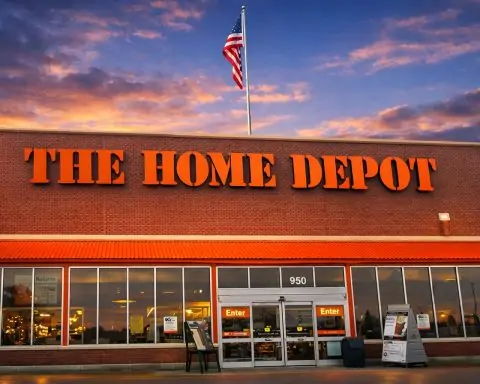Coles Group Limited (ASX:COL) traded in a tight range on Friday, 28 November 2025, with the supermarket giant’s share price hovering around A$22.37 in afternoon trade on the ASX, effectively flat compared with recent closes. Coles’ own investor site showed an intraday range between A$22.18 and A$22.40 with volume just over 2 million shares changing hands by mid-session. [1]
While there were no fresh ASX announcements from Coles today, the stock remained in focus as the market continued to digest last month’s first-quarter sales update, the 2025 AGM commentary on automation, and ongoing scrutiny of Australia’s supermarket sector. [2]
Coles share price today: stable in a cautious market
On 28 November 2025, Coles shares traded around A$22.37, broadly unchanged on recent sessions and implying only a marginal move versus the late-November closing range of A$22.30–A$22.40. [3]
Daily trading data showed: [4]
- Open: A$22.18
- Intraday high: Around A$22.40
- Intraday low: Around A$22.18
- Volume (by mid-afternoon): ~2.1 million shares
In other words, today’s action was about sentiment, not headlines. The lack of new company-specific news left the share price largely anchored to its recent range while the broader market focused on macro themes.
Over the past few months, Coles has quietly outperformed: one recent analysis noted the stock had gained roughly 12% over the last three months, reflecting investors’ renewed appetite for defensive, dividend-paying names. [5]
Coles’ market capitalisation is now close to A$30 billion, placing it firmly among the heavyweights of Australia’s consumer sector alongside Woolworths and Wesfarmers-owned Bunnings and Kmart. [6]
What’s driving sentiment: Q1 sales growth, but expectations are high
Although today brought no new earnings updates, the current valuation is still being shaped by news from late October and early November.
First-quarter sales: solid growth, slight miss vs expectations
In late October, Coles reported first-quarter FY26 (company Q1 2025) sales revenue of about A$10.96 billion, up from roughly A$10.55 billion a year earlier – an increase of around 4%. Supermarket sales grew in the low-single digits, supported by customer growth and strong online demand, while liquor remained softer. [7]
However, an earnings-call transcript and analyst commentary highlighted that revenue came in fractionally below market forecasts, with one source putting the shortfall at roughly 0.5–0.6% versus consensus. [8]
So the current mood around Coles is a blend of:
- Acknowledgement of resilient, inflation-era sales, especially in supermarkets; and
- Recognition that expectations were already elevated, meaning even a small revenue undershoot can cap short-term share price upside.
AGM messaging: automation, supply chain and crime
At the 11 November 2025 AGM, Coles’ management doubled down on the long-term strategy: investing in automated distribution centres, digital capabilities and supply chain resilience. AGM documentation and investor commentary flagged four large automated sites as key pillars of this transformation. [9]
The company reiterated that FY25 Net Profit After Tax rose to about A$1.07 billion, an increase of roughly 2–3% on a normalised basis, and confirmed a fully-franked total FY25 dividend of 69 cents per share, returning more than A$900 million to shareholders. [10]
Earlier coverage of Coles’ full-year results also noted:
- Group sales up around the mid-single digits, with supermarkets the main growth driver;
- Liquor growing more modestly; and
- A notable lift in EBITDA and EBIT, helped by efficiency programs and simplification of the network. [11]
Separately, management has warned publicly about escalating retail crime, particularly in Victoria, describing theft and safety incidents as a growing cost and operational challenge even as the company tries to maintain value for shoppers facing cost-of-living pressures. [12]
Newsflow on 28 November 2025: Coles in the bigger ASX story
While there were no new ASX announcements or company-specific press releases from Coles today, the stock was referenced in broader market coverage on 28 November.
ASX 200 focus: defensives in the spotlight
An FNArena feature on the S&P/ASX 200 composition published today highlighted Coles, Woolworths and Wesfarmers as key retail names that mirror Australian consumer spending trends. The article characterised these stocks as “stable businesses generating consistent returns during normal economic conditions” – not hyper-growth plays, but core holdings for investors seeking income and relative resilience. [13]
That framing aligns with how many institutional investors currently treat Coles: a defensive, dividend-paying staple stock rather than a high-beta growth story.
Macro backdrop: RBA rate-hike jitters into 2026
Also today, market commentary centred on what to do with ASX shares as investors look ahead to possible Reserve Bank of Australia rate hikes in 2026. While not about Coles specifically, such pieces typically name supermarket giants as potential “shelter” stocks when interest-rate and economic uncertainty rise, because grocery demand tends to be more stable through the cycle. [14]
Put simply, today’s news is less “Coles-specific headline” and more “Coles as a character in the broader ASX and macro narrative”.
Regulatory and competitive pressures still loom in the background
Behind today’s quiet tape are several slow-burn themes that investors continue to monitor.
ACCC supermarket inquiry
The Australian Competition and Consumer Commission (ACCC) is deep into its wide-ranging inquiry into supermarket pricing and market power, looking at the relationship between wholesale and retail prices and the degree of competition in the sector. Coles and Woolworths, which together control a large share of the grocery market, are central to that investigation. [15]
This isn’t a “today only” story – it’s more of a multi-year background risk that could influence everything from promotional strategies to potential regulatory interventions.
ACCC review of specific Coles deals
In September, the ACCC began an informal review of a proposed acquisition of a leasehold interest in Victoria by Coles, leading to a short-term share price dip at the time. [16]
That review fits into the broader pattern: authorities and the public are questioning whether the major supermarket chains have too much power in both real estate and pricing.
Competition from Woolworths and others
Analysts note that while Coles maintained a sales growth lead over Woolworths in the most recent quarter, the performance gap may be narrowing as Woolworths ramps up discounting and sharpens its inventory management. [17]
At the same time, newer and smaller rivals, online grocery services and specialty stores are steadily eroding the duopoly’s share at the margin – a trend that shows up in long-form analyses of the sector’s history and structure. [18]
How Coles looks from a fundamentals lens (as of late November 2025)
Putting all this together, here is how Coles’ fundamental picture looks today, based on recently published information:
- Scale and positioning: Around 860 supermarkets and close to 1,000 liquor stores nationwide, plus growing e-commerce and retail media operations, make Coles one of Australia’s most entrenched consumer franchises. [19]
- Recent profit trend: FY25 NPAT up low-single digits on a normalised basis, reflecting growth in supermarkets and controlled costs. [20]
- Dividends: Total FY25 dividend of 69 cents per share fully franked, implying a trailing yield a touch above 3% at current prices, according to recent broker and financial-data commentary. [21]
- Q1 trajectory: Group sales up around 4% year on year, with supermarkets solid and liquor more subdued, but revenue coming in slightly under consensus expectations. [22]
- Balance of risks:
- Positives: strong brand, scale advantages, cost-out and automation initiatives, and dependable cash flows.
- Negatives: political and regulatory pressure, intense competition on price, higher wage and energy costs, and ongoing investment needs for logistics and technology.
From an investor’s perspective, all of that helps explain why today’s calm share price action makes sense: the market has a reasonably clear picture of Coles’ trajectory, and there’s no new information today big enough to jolt that view.
Key things to watch after today
Looking beyond 28 November 2025, the main catalysts likely to matter for Coles’ stock include:
- Further ACCC findings from the supermarket inquiry and any follow-up proposals on pricing or competition. [23]
- Updates on automation projects and whether they deliver the promised cost savings and supply-chain resilience highlighted at the AGM. [24]
- Next quarterly sales trading updates, which will show whether Coles can sustain real (inflation-adjusted) growth as cost-of-living pressures weigh on household budgets. [25]
- RBA policy changes in 2026, and how higher or prolonged interest rates affect consumer spending patterns, particularly in discretionary categories and liquor. [26]
References
1. www.colesgroup.com.au, 2. www.colesgroup.com.au, 3. www.colesgroup.com.au, 4. www.colesgroup.com.au, 5. finance.yahoo.com, 6. stockanalysis.com, 7. www.marketscreener.com, 8. www.investing.com, 9. www.colesgroup.com.au, 10. www.colesgroup.com.au, 11. www.colesgroup.com.au, 12. www.proactiveinvestors.com.au, 13. fnarena.com, 14. www.fool.com.au, 15. www.accc.gov.au, 16. www.marketscreener.com, 17. www.reuters.com, 18. www.abc.net.au, 19. www.colesgroup.com.au, 20. www.colesgroup.com.au, 21. www.marketscreener.com, 22. www.marketscreener.com, 23. www.accc.gov.au, 24. www.colesgroup.com.au, 25. www.reuters.com, 26. www.fool.com.au










